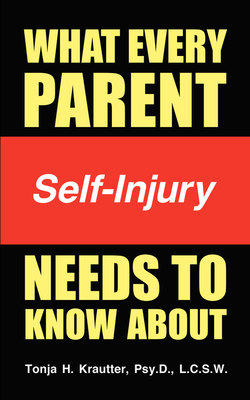What Every Parent Needs to Know About Self-Injury

Реклама. ООО «ЛитРес», ИНН: 7719571260.
Оглавление
Tonja Krautter. What Every Parent Needs to Know About Self-Injury
Introduction
What is Self-Injury?
A Physical Expression of Emotional Pain
Who Self-Injures?
Types of Self-Injury
Escalation
Accessibility
How is Self-Injury Discovered?
Why Does Self-Injury Feel Addictive
Feelings and Cognitions Associated with Self-Injury
Understanding Self-Injury
Self-Injury vs. Suicide
Is Self-Injury High Risk or Low Risk?
The Most Common Reasons Why Individuals Self-Injure
1. To Escape Emptiness and Feel Alive
2. As Punishment
3. To Numb Feelings
4. To Decrease Tension
5. A Coping Mechanism
Identifying Self-Injury
Warning Signs
Parent Checklist - Physical Signs
Parent Checklist - Emotional Signs
Giving Voice to Pain that has No Words
Acknowledging the Problem
Finding Motivation
Prevention
Early Detection
Assessing Your Child
Parent Assessment Questions. Ask the following:
The Importance of Role Modeling
Communicating with Your Child: Tips for Parents and Caregivers
Societal Influences
Immediate Gratification
Disenfranchised Youth
Dysfunctionality: the New Cool
Emphasis on the Superficial
Advances in Technology
Increased Pressure
Increased Desire for Stimulation
Overcoming Resistance and Entering Treatment
Explaining that Treatment is Mandatory
Specific Strategies to Overcoming Resistance
1. There is no problem!
2. You caused the problem and if you force me into treatment you will make it worse!
3. You are the one with the problem, so why don’t you go to therapy instead!
4. I can fix the problem on my own, so don’t waste your money on someone I don’t want to see in the first place!
5. If you make me go to treatment, I will sit there and won’t talk, so it’s a waste of your time and money!
6. If you make me go to treatment, I will run away or even worse I will try to kill myself!
Why do Individuals Avoid the Problem?
1. Emotional Reasons
2. Societal View of the Problem
3. Fear of Being Labeled
Individual Perspectives on Entering Treatment
Choosing the Right Therapist
Building a Therapeutic Alliance
Intervention and Recovery
The Road to Recovery
Self-Injury is a Behavior, Not an Identity
Treatment Options
Individual Therapy
The Cognitive Behavioral Cycle
Impulse Control Log
Alternative Behaviors
Symptom Jumping
The Pressure Cooker Theory
Insight-Oriented Therapy
Other Treatment Options
Group Therapy
Family Therapy
Inpatient Treatment
Ending Treatment and Relapse Prevention
Reasons for Relapse
Relapse Prevention
Ending Treatment
Inspiring Stories
Francesca, Age 19
Morgan, Age 19
Candice, Age 21
Sierra, Age 14
Michael, Age 17
Kaylee, Age 16
Susan, Single Mom
Hillary, Age 15
Katherine, Age 24
Kelly, Age 22
Kelly’s Mom
About the Author
Appendix A: Specific Treatment Options
Отрывок из книги
As often as ten times a week, I receive calls from parents devastated to learn that their child is engaging in self-injurious behavior. Regardless of what it has been called (the bright red scream, the new-age anorexia, or the newest addiction) the practice of self-injury is on the rise. Shock, fear, anger, and confusion overwhelm parents when they are told that the child they have struggled to protect since birth is now choosing to harm herself. I use the feminine pronoun because while this phenomenon is not limited to one gender, it is more visible among females than males. It is also not limited to a particular age, race, culture or socioeconomic status.
It seems incomprehensible, especially to parents, that a child would take a knife, razor blade, lighter or fist and intentionally harm herself. Parents ask, “What is my child trying to achieve?” The answer, unfortunately, is not simple. There are multiple reasons why kids self-injure. Accordingly, helping them to recover from this problem must start with a thorough examination of the problem itself.
.....
The second source of inspiration for this book came from something I learned in my profession: Highly-stressed individuals need a means to relieve their internal tension. This certainly applies to individuals who self-harm. Some individuals deal with distress in positive, healthy ways such as exercise, journaling, and/or artistic outlets. Others turn to negative and unhealthy means of stress relief, including substance abuse, disordered eating and/or self-injury. For an individual who self-injures, it is usually a combination of this personal distress with certain personality traits, family dynamics and cultural influences, that leads to the onset and maintenance of this problem.
Once fully established, the problem can be viewed as a cycle of negativity that has destructive consequences for the individual, and in turn, for everyone else in the family unit. Mental health professionals constantly search for creative ways to reduce a patient’s isolation and help them to obtain the support necessary to feel more understood. The opportunity to hear and learn from the stories of other individuals who have dealt with self-injurious behavior helps both patients and their families gain insight and feel less alone.
.....